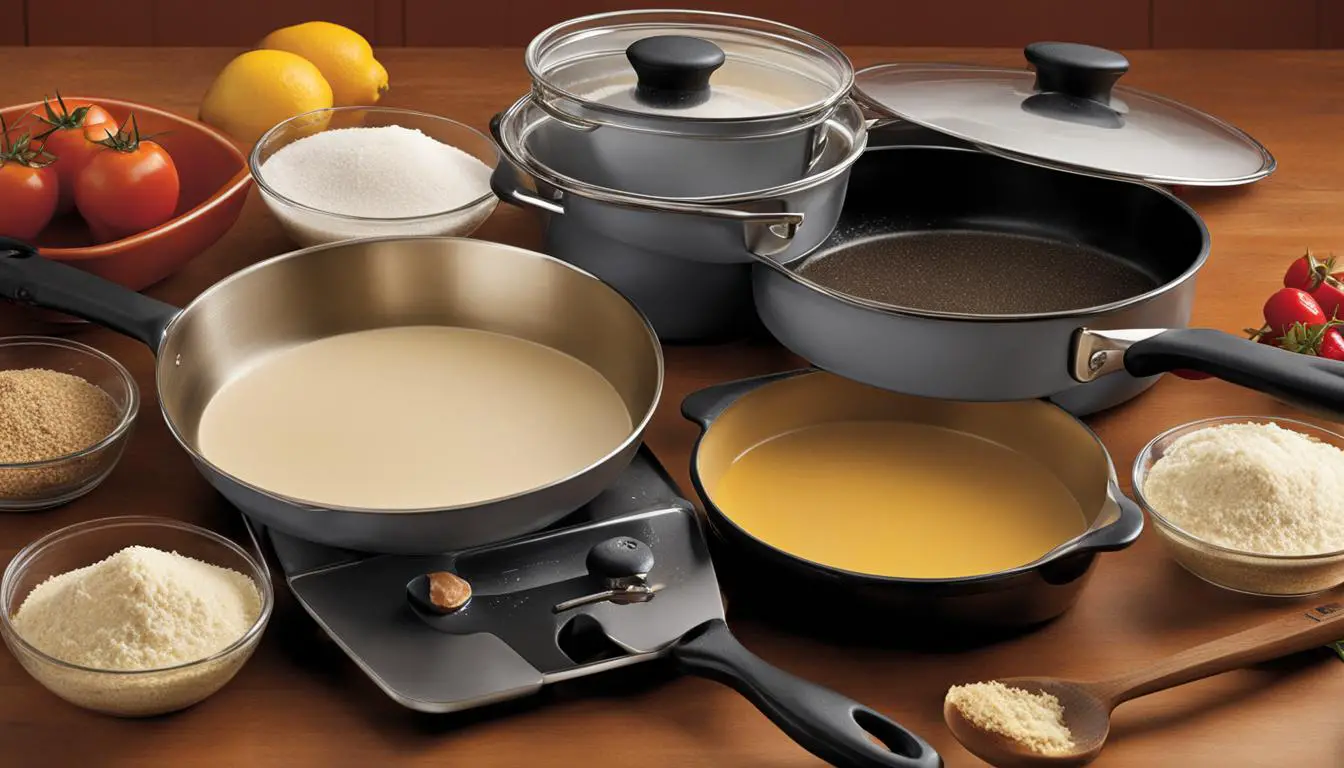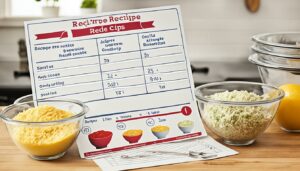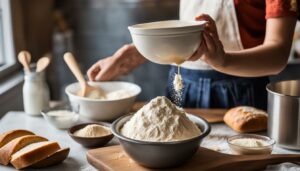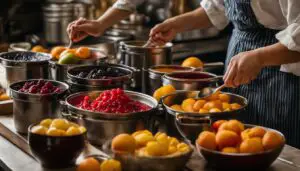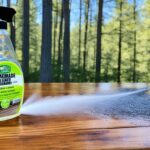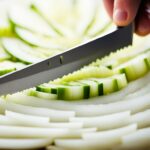Originally posted on December 13, 2023 @ 9:17 pm
When doubling a 9×13 recipe, it’s important to select the right pan size to ensure that your baked goods turn out perfectly. Luckily, there are several pan options available that will allow you to double your recipe without compromising taste or texture. Whether you prefer square pans, round pans, or sheet pans, there is a pan size that will suit your needs.
Contents
- 1 How to Double a 9×13 Recipe
- 2 Pan Size Options for Doubling a 9×13 Recipe
- 3 Pan Recommendations and Adjustments
- 4 Troubleshooting Overflowing Sheet Pans
- 5 Companion to Amycakes Bakes Cakes Recipes
- 6 Adapting Cake Pan Sizes in Baking Recipes
- 7 Substituting Pans for Different Recipes
- 8 Conclusion
- 9 FAQ
- 9.1 What factors should I consider when doubling a 9×13 recipe?
- 9.2 What pan size options are available for doubling a 9×13 recipe?
- 9.3 What is the recommended pan size for doubling a 9×13 recipe?
- 9.4 How can I prevent overflowing when using a sheet pan for a doubled recipe?
- 9.5 Are there recommended pan sizes for Amycakes Bakes Cakes recipes?
- 9.6 How can I adapt pan sizes in baking recipes?
- 9.7 What can I use as a substitute for a specific pan size in a recipe?
- 9.8 What are some tips for adapting pan sizes in recipes?
- 10 Source Links
Key Takeaways:
- Choosing the right pan size is crucial when doubling a 9×13 recipe.
- Square pans, round pans, and sheet pans are all suitable options.
- A ½ sheet pan, three 9″ round pans, or four 8″ round pans are recommended for doubling a 9×13 recipe.
- Consider adjusting the baking time when using different pan sizes.
- Amycakes Bakes Cakes recipes provide specific pan size recommendations and baking times for doubled batches.
How to Double a 9×13 Recipe
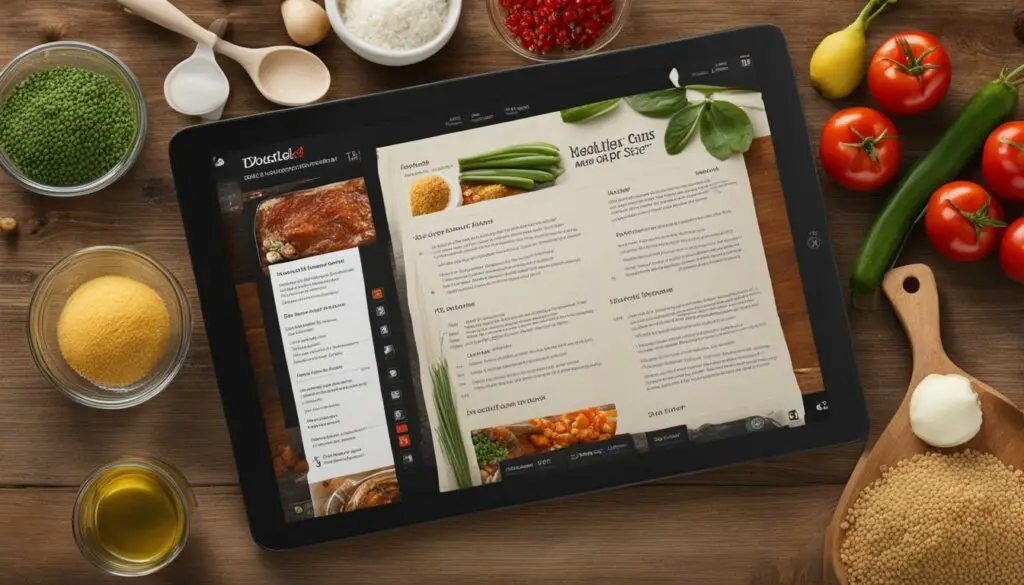
When doubling a 9×13 recipe, it’s important to follow the instructions and measurements carefully to ensure that the proportions are correct. To double a 9×13 recipe, you can usually just double all of the ingredients listed in the recipe. However, if the recipe calls for an unusual measurement, such as ½ tablespoon or ⅛ cup, you may need to make some adjustments.
It’s also important to consider the pan size that you will be using to bake your doubled recipe. The pan size will determine the baking time and the overall presentation of the finished dish.
To scale up a 9×13 recipe in a larger pan, follow these steps:
- Double all the ingredients listed in the original recipe. This ensures that the proportions remain consistent and that the flavors are balanced.
- If the recipe calls for an unusual or non-standard measurement, such as ½ tablespoon or ⅛ cup, make the necessary adjustments to ensure accuracy.
- Choose a larger pan size that can accommodate the doubled recipe. This can be a square pan, a round pan, or a sheet pan, depending on your preference.
- Adjust the baking time as needed. Larger pans may require longer baking times to ensure that the dish is cooked through.
By following these steps, you can successfully convert a 9×13 recipe into a larger pan size without compromising on taste or texture. Enjoy your delicious doubled recipe!
Example Conversion:
Let’s say you have a recipe for a 9×13 chocolate cake. Here’s how you can double it and convert it to a larger pan size:
- Original recipe calls for 2 cups of all-purpose flour. Double that to 4 cups.
- In the original recipe, you need 1 cup of granulated sugar. Double that to 2 cups.
- If the recipe calls for 1 teaspoon of vanilla extract, you’ll still use 1 teaspoon in the doubled recipe.
- Choose a larger pan size, such as a 12×18 sheet pan, to accommodate the doubled recipe.
- Adjust the baking time. The original recipe may take 30 minutes to bake in a 9×13 pan, but the doubled recipe in a larger pan may take closer to 45 minutes. Check for doneness with a toothpick inserted into the center of the cake.
| Ingredient | Original Recipe (9×13) | Doubled Recipe (Larger Pan) |
|---|---|---|
| All-Purpose Flour | 2 cups | 4 cups |
| Granulated Sugar | 1 cup | 2 cups |
| Baking Powder | 1 teaspoon | 1 teaspoon |
| Salt | 1/2 teaspoon | 1/2 teaspoon |
| Milk | 1 cup | 2 cups |
| Vegetable Oil | 1/2 cup | 1 cup |
| Eggs | 2 | 4 |
Keep in mind that these measurements and pan sizes are just an example. It’s important to adjust the recipe and pan size according to your specific needs.
Pan Size Options for Doubling a 9×13 Recipe

When it comes to doubling a 9×13 recipe, selecting the right pan size is crucial for achieving delicious results. Fortunately, there are several pan options available that will allow you to double your recipe without any hassle. Whether you prefer a square, round, or sheet pan, you can find a size that suits your needs. Let’s explore the pan size options for doubling a 9×13 recipe.
1. ½ Sheet Pan
A ½ sheet pan, measuring 13″x18″x1″, is an excellent option for doubling a 9×13 recipe. This larger rectangular pan provides ample space for a cake or casserole, ensuring even baking and a fantastic end result.
2. Round Cake Pans
Using round cake pans is another great option for doubling a 9×13 recipe and creating layer cakes or individual cakelets. You can choose to use three 9″ round cake pans or four 8″ round cake pans.
3. 12×18 Sheet-Cake Pan
If you prefer a slightly larger rectangular cake, you can utilize a 12×18 sheet-cake pan for your doubled recipe. This pan size will give you more surface area while still maintaining the essence of the original 9×13 recipe.
It’s important to keep in mind that the baking time may vary depending on the pan size you choose. Make sure to adjust the baking time accordingly to ensure your doubled recipe is baked to perfection.
Pan Recommendations and Adjustments
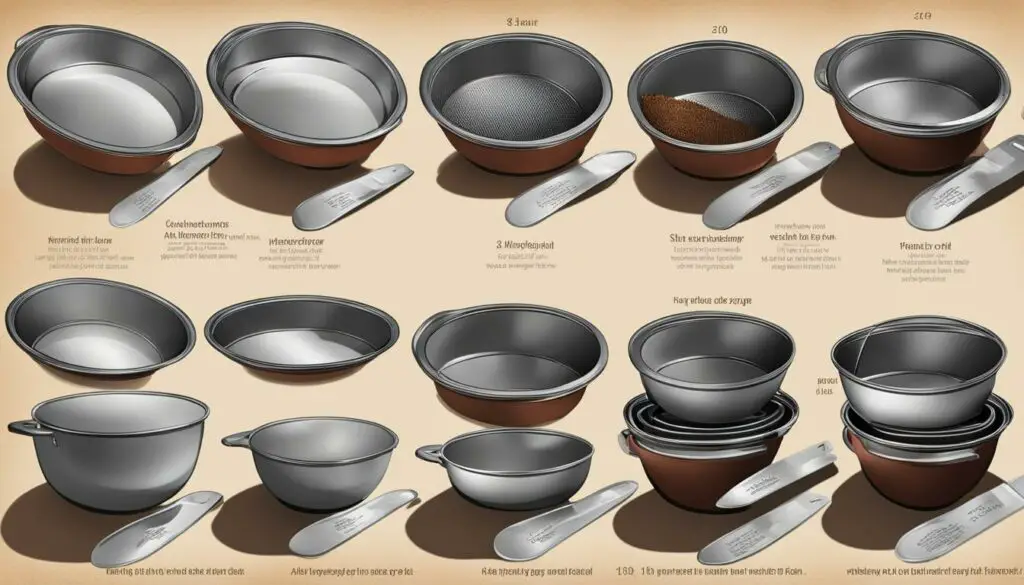
When doubling a 9×13 recipe, it’s helpful to have the right pan size to ensure even baking and the best results. For a doubled recipe, using a ½ sheet pan (13″x18″x1″) is recommended. This pan size will allow your cake or casserole to bake evenly without overflowing or burning.
If you don’t have a ½ sheet pan, you can use three 9″ round cake pans or four 8″ round cake pans. These round pans will give you the option to create layer cakes or individual cakelets. Just remember to adjust the baking time accordingly for each pan size to ensure that your doubled recipe bakes through completely.
| Pan Type | Size | Recommended Uses |
|---|---|---|
| ½ Sheet Pan | 13″x18″x1″ | Perfect for doubling a 9×13 recipe. Great for sheet cakes and casseroles. |
| 9″ Round Cake Pan | 9″ diameter, 2″ deep | Creates layer cakes or individual cakelets when using three pans. |
| 8″ Round Cake Pan | 8″ diameter, 2″ deep | Creates layer cakes or individual cakelets when using four pans. |
Troubleshooting Overflowing Sheet Pans
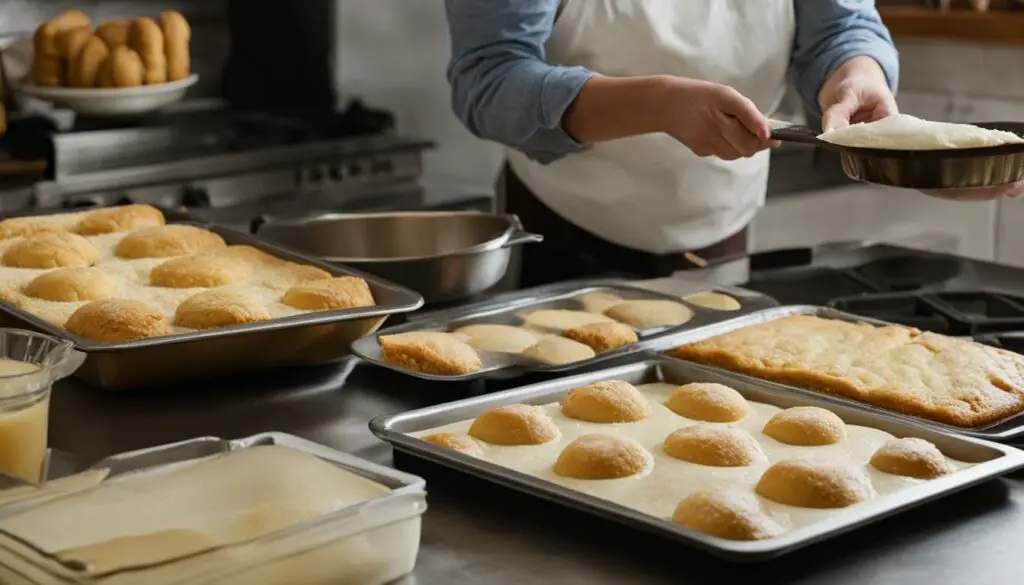
When it comes to baking a doubled recipe in a sheet pan, there is a potential challenge that you might face—overflowing batter. This can occur due to a few factors, such as an oven temperature that is too low or using a sheet pan that is uneven or shorter than recommended. However, there are solutions to prevent this issue and ensure a successful bake.
Here are some troubleshooting tips to prevent overflowing when using a sheet pan for a doubled recipe:
- Check your oven temperature: Make sure that your oven is preheated to the correct temperature specified in the recipe. If the oven temperature is too low, the batter may take longer to bake and could rise excessively, causing overflow.
- Use a taller sheet-cake pan: If you frequently experience overflowing with your current sheet pan, consider using a taller pan that provides extra room for a doubled batch. A 9×13 sheet-cake pan is recommended for a 1x batch, while a 12×18 pan is suitable for doubling the recipe.
- Fill gaps with cake scraps: To ensure an even and level cake, you can fill any gaps in the pan with cake scraps. This helps to prevent uneven rising and creates a more uniform appearance for your baked goods.
By following these troubleshooting tips, you’ll be able to avoid overflowing sheet pans and achieve delicious results with your doubled recipes. Happy baking!
Companion to Amycakes Bakes Cakes Recipes
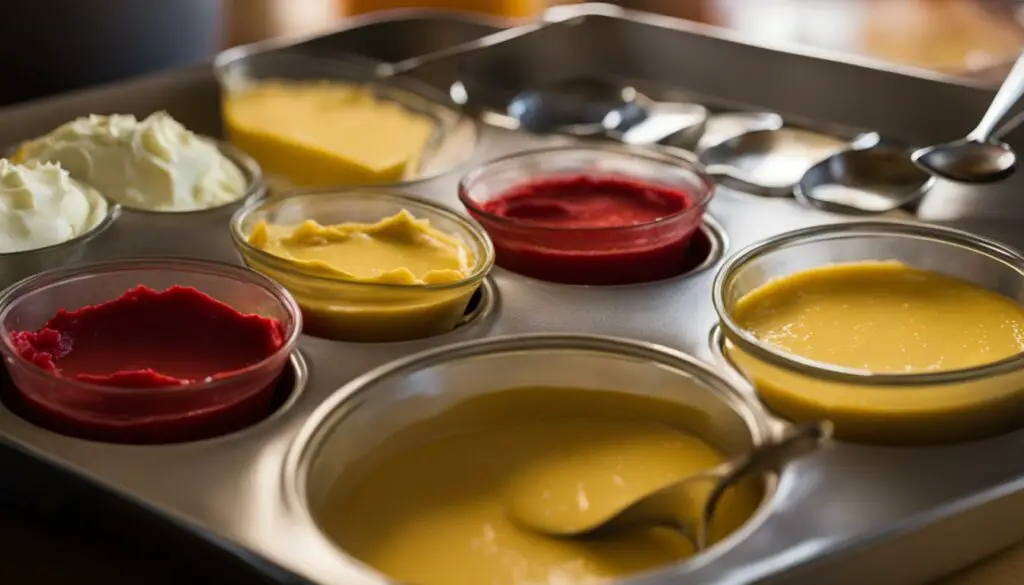
Amycakes Bakes Cakes is your go-to resource for delicious small-batch cake recipes that can be easily doubled. Whether you’re hosting a special occasion or simply craving some homemade sweetness, Amycakes has you covered. Their recipes not only provide mouthwatering flavors but also offer specific pan size recommendations and baking times for both single and double batches. Let’s take a closer look at how Amycakes helps you create perfect treats every time.
When it comes to pan sizes for Amycakes Bakes Cakes recipes, you can expect detailed guidance. From their expertise, they recommend using a ½ sheet pan (13″x18″x1″) or three 9″ round cake pans when doubling a recipe that yields 14 servings. These pan sizes ensure even baking and the ideal texture for your cakes.
In addition to the standard pan options, Amycakes also gives you the flexibility to create different cake sizes. With the help of cake rings, you can easily transform their recipes into 8″ cakes, 6″ cakes, or even small cakelets. This allows you to customize your desserts for any occasion or preference.
It’s important to follow the recommended pan sizes and baking times provided by Amycakes Bakes Cakes for the best results. By doing so, you’ll achieve perfectly baked cakes that are as delicious as they are visually appealing.
With Amycakes Bakes Cakes recipes, you can confidently embark on your baking journey knowing that they have taken the guesswork out of pan sizes and baking times. The result? Delectable treats that are sure to impress family and friends. So, grab your mixing bowl, preheat that oven, and let Amycakes guide you to baking success!
Adapting Cake Pan Sizes in Baking Recipes

Adapting cake pan sizes in baking recipes is a common challenge that many home bakers face. It can be frustrating to come across a recipe that calls for a specific pan size that you don’t have. However, with a little math and understanding of pan capacities, you can easily adapt recipes to the pans you already own.
One important consideration when adapting cake pan sizes is the bottom surface area of the pans. By measuring the bottom surface area, you can determine which pans will substitute best for one another. For example, an 8″ square pan and a 9″ round pan have the same capacity and can be interchangeably used in recipes. The same applies to other common pan sizes like 9″ square and 9″ round pans.
It’s important to note that the depth of the pans also plays a role in baking time and overall results. Deeper pans may require longer cooking times, while shallower pans may result in faster baking. It’s crucial to closely monitor your recipe and adjust the baking time as needed.
When adapting cake pan sizes, it’s essential to consider both the capacity and depth of the pans to ensure the best baking results. By understanding which pans can be substituted for one another, you can confidently tackle any recipe and achieve delicious baked goods every time.
Substituting Pans for Different Recipes
When a recipe calls for a specific pan size that you don’t have, there are alternative pan sizes that you can use instead. By understanding the surface area of different pan sizes, you can make informed substitutions and still achieve great results.
For example, if a recipe calls for an 11″ x 7″ pan and you don’t have one, you can use an 8″ square pan or a 9″ round pan as a substitute. Oval casserole dishes can also be used as a substitute for rectangular pans in some cases. It’s important to note that baking times may vary when using alternative pan sizes, so be sure to monitor the recipe closely and adjust as needed.
| Pan Shape | Original Size | Possible Substitutes |
|---|---|---|
| Square | 8″ x 8″ | 9″ x 9″ or 10″ x 10″ |
| Round | 9″ diameter | 8″ diameter or 10″ diameter |
| Rectangular | 9″ x 13″ | 8″ x 12″, 10″ x 14″, or 11″ x 15″ |
By having a good understanding of alternative pan sizes and their capacities, you can confidently adapt recipes to the pans you already have in your kitchen. Just remember to consider the depth of the pans, as this can affect baking time and overall results. Happy baking!
Conclusion
Doubling a 9×13 recipe can be easily accomplished by selecting the right pan size and making a few adjustments. Whether you choose a ½ sheet pan, round cake pans, or alternative sizes, considering the capacity and depth of the pans is key for even baking and optimal results.
By following the recommended pan size options and tips provided in this article, you can confidently double your favorite 9×13 recipes without compromising the taste or texture. Whether you’re baking a large cake or a casserole, there are pan options available that will suit your needs.
Additionally, when adapting pan sizes in other recipes, it’s important to understand the surface area and capacity of different pans. By making informed substitutions, like using an 8″ square pan instead of an 11″ x 7″ pan, you can still achieve delicious results.
So, next time you need to double a 9×13 recipe or adapt pan sizes in your baking, remember these tips and enjoy the process with confidence. Happy baking!
FAQ
What factors should I consider when doubling a 9×13 recipe?
When doubling a 9×13 recipe, it’s important to follow the instructions and measurements carefully to ensure that the proportions are correct. You should also consider the pan size that you will be using to bake your doubled recipe, as this will determine the baking time and overall presentation of the dish.
What pan size options are available for doubling a 9×13 recipe?
When doubling a 9×13 recipe, you have several pan size options available. Some popular choices include using a ½ sheet pan (13″x18″x1″), three 9″ round cake pans, four 8″ round cake pans, or a 12×18 sheet-cake pan. Each pan size will give you a different shape and size of the finished dish.
What is the recommended pan size for doubling a 9×13 recipe?
The recommended pan size for doubling a 9×13 recipe is a ½ sheet pan (13″x18″x1″). This pan size will allow your cake or casserole to bake evenly without overflowing or burning. If you don’t have a ½ sheet pan, you can use three 9″ round cake pans or four 8″ round cake pans as an alternative.
How can I prevent overflowing when using a sheet pan for a doubled recipe?
To prevent overflowing when using a sheet pan for a doubled recipe, it’s important to be aware of any potential issues such as a low oven temperature or an uneven or shorter pan. If you frequently experience overflow, it is recommended to use a taller sheet-cake pan, such as a 9×13 for a 1x batch or a 12×18 for a doubled batch. You can also fill in any gaps with cake scraps to ensure an even and level cake.
Are there recommended pan sizes for Amycakes Bakes Cakes recipes?
Yes, Amycakes Bakes Cakes provides specific pan size recommendations and baking times for both single and double batches of their recipes. For a doubled batch of 14 servings, they recommend using a ½ sheet pan (13″x18″x1″) or three 9″ round cake pans. They also provide options for creating different cake sizes, such as an 8″ cake, 6″ cake, or small cakelets, using cake rings.
How can I adapt pan sizes in baking recipes?
To adapt pan sizes in baking recipes, you can measure the bottom surface area of your pans and determine which pans will substitute best for one another. For example, an 8″ square pan and a 9″ round pan have the same capacity and can be interchangeably used in recipes. It’s important to consider the depth of the pans as well, as this can affect baking time and overall results.
What can I use as a substitute for a specific pan size in a recipe?
When a recipe calls for a specific pan size that you don’t have, there are often alternative pan sizes that can be used instead. For example, if a recipe calls for an 11″ x 7″ pan and you don’t have one, you can use an 8″ square pan or a 9″ round pan as a substitute. Oval casserole dishes can also be used as a substitute for rectangular pans in some cases. Just be sure to monitor the recipe closely and adjust baking times as needed.
What are some tips for adapting pan sizes in recipes?
When adapting pan sizes in recipes, it’s important to consider the surface area and capacity of the pans. Measuring the bottom surface area can help determine which pans will substitute best for one another. It’s also important to adjust the baking time and temperature when using different pan sizes, as this can affect how the recipe bakes through. Monitoring the recipe closely and making any necessary adjustments will help ensure the best results.

